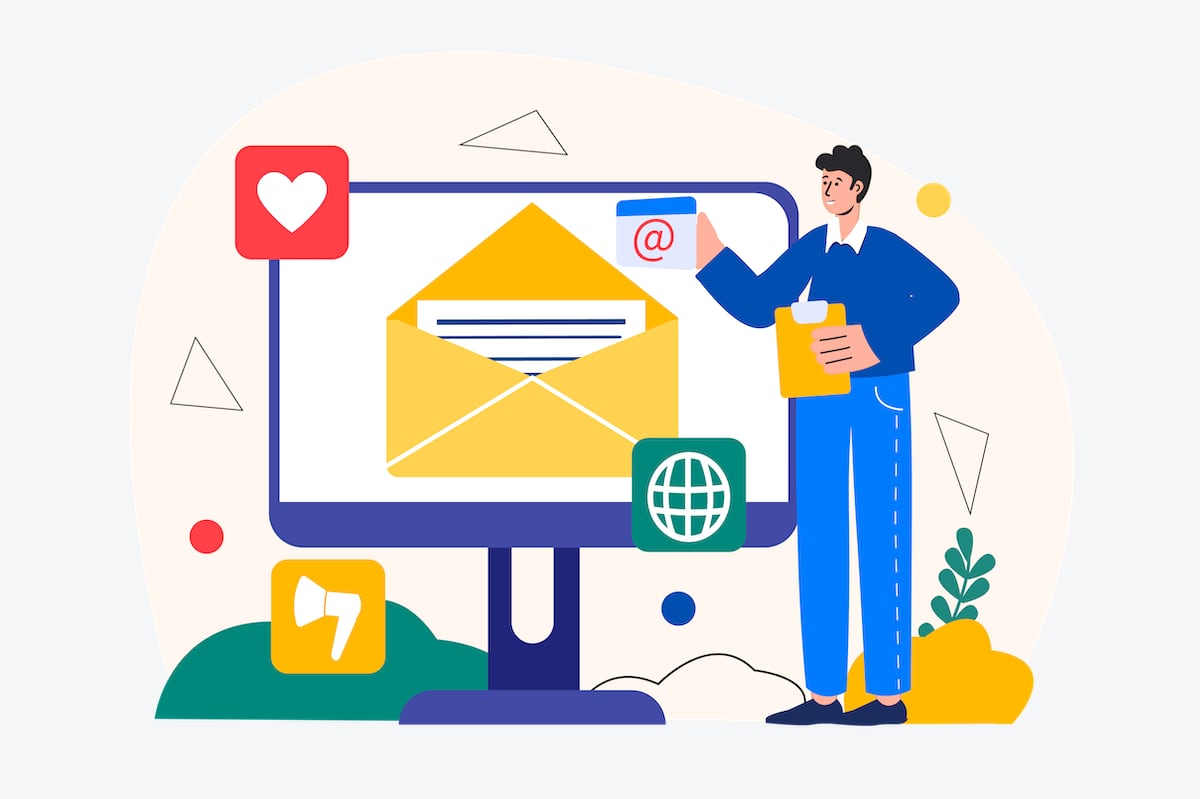B2B emailing remains a key channel for communicating and prospecting. Unlike social networks, which depend on third-party platforms, it offers total control over the contact base and enables precise targeting. However, just because you send an email doesn’t necessarily mean it lands in your inbox.
That’s what deliverability is all about: getting past the technical and anti-spam filters set up by professional e-mail services. In B2B, corporate security rules are often more restrictive. To ensure that a campaign reaches its target audience, you need to take care not only of the technical aspects (SPF, DKIM, DMARC), but also of the relevance of the content and the frequency of delivery.
Understanding the challenges of B2B deliverability
Deliverability directly conditions the impact of a campaign: if your messages don’t reach the inbox, they won’t be opened or clicked. Beyond the loss of opportunities, there’s also the risk of damaging your brand image, as messages marked as undesirable can end up being blocked.
Unlike B2C, where Gmail and Outlook manage general-purpose mailboxes, B2B companies often use their own servers and security rules. The result: stricter anti-spam filters, restrictions on attachments or new senders. The issue of deliverability is therefore even more sensitive.
Finally, poor deliverability means wasted time and money: you’re sending emails that never arrive. Understanding these technical and organizational specifics is therefore essential to improving the effectiveness of your campaigns.
Technical factors to master
To prove that your e-mails really come from you, configure the SPF, DKIM and DMARC authentication protocols. Without them, your messages are more likely to end up as spam or be blocked by mail servers.
The sending server must be beyond reproach: dedicated (or trusted) IP, verified online reputation and correct DNS configuration. If your IP has a bad reputation, your e-mails will end up in the spam folder, even if they are legitimate.
Clean up your contact database regularly. Remove invalid addresses, keep track of unsubscribes and monitor complaints. This preserves your reputation as a sender and limits the bounce rate.
The importance of content and delivery strategy
Messaging providers analyze both form (high-risk keywords, links, visuals) and content (relevance, personalization). To improve your open rates, you need to :
- Make sure your email subject line is clear, personalized and not too commercial.
- Structuring content: avoid endless blocks of text, and ensure readability on mobile devices.
- Stay consistent: the sender’s name should inspire confidence, and the preheader should complement the subject line.
In B2B, we prefer fine-tuned segmentation and targeted mailings. It’s better to send few relevant campaigns than many generic messages. Here’s a quick comparison between B2C and B2B:
| Criteria | B2C emailing | Emailing B2B |
|---|---|---|
| Content type | Promotions, flash offers | White papers, case studies, webinar invitations |
| Editorial style | More direct, emotional tone | Professional, more formal and argumentative tone |
| Sending frequency | Often high (daily deals, newsletters) | Less frequent, focused on added value |
| Purchase decision | Often impulsive or emotional | Well-considered decision, involving several people |
Respecting these B2B specificities avoids saturating your targets’ mailboxes and ensures you stay on the radar of decision-makers. Think about the time of day too: sending an email at 11pm doesn’t always make sense to a B2B recipient.
Test, analyze and optimize deliverability
To measure the real effectiveness of a campaign and anticipate deliverability problems, simply observing the open rate is not enough. Before sending to the entire base, set up a pre-test phase with a seed list (several test addresses from different suppliers, including B2B boxes). Then use tools that analyze the probability of going spam (e.g. mail-tester or GlockApps). They provide a “spamminess” score based on HTML structure, presence of trigger words, SPF/DKIM/DMARC configuration, etc.
Once the campaign is up and running, monitor indicators that are more refined than the traditional “open rate”. Observe responsiveness over time (click-through rate, conversions over several days), because in B2B, the decision to open and then click can be delayed. Also look for bounce codes:
- Permanent bounce (hard): the address no longer exists, and must be deleted immediately.
- Temporary (soft) bounce: box full or server temporarily unavailable. Watch out for repeated bounces, a possible sign of recurring problems on the recipient’s side or a bad sender reputation.
- Complaints: when the recipient marks the e-mail as undesirable. A few isolated complaints are inevitable. But too high a rate (over 0.1%) indicates a problem with targeting or content.
In B2B, this feedback may be less immediate than in B2C, as professional servers don’t always send automated loop feedback. Hence the importance of regular technical monitoring (routing logs, delivery rates) to spot any anomalies.
Keep in mind that deliverability is not static. Your reputation as a sender evolves according to your sending practices (volumes, relevance, complaints received). So test and adjust continuously:
- IP warming: if you’re using a new dedicated IP, gradually increase volumes.
- Rotation of segments: don’t always solicit the same contacts; prioritize those who interact positively to maintain a good reputation.
- Regular A/B testing: test different objects, frequencies or content angles. The feedback will help you refine your next campaigns.
- Domain reputation monitoring: reputation is as much about the IP as it is about the domain name. If your domain is associated with too many complaints, B2B filters may block you.
With this strategy of advanced testing, monitoring of key metrics and continuous optimization, you remain proactive: you quickly identify problems and correct your approach to maintain a good deliverability rate.
Concrete strategies to boost B2B deliverability
Start by clarifying your segmentation and targeting. In B2B, an email relevant to a marketing manager may seem irrelevant to a CFO. Create lists segmented by position, business sector or relationship history. This increases the consistency of messages sent and limits the risk of complaints or disinterest.
Vary your content to show your added value:
- Case studies: illustrate your know-how in real-life situations.
- White papers, e-books: delve deeper into a subject that your prospects need to master.
- Targeted invitations: offer a webinar or event where your contacts can ask their questions directly.
These approaches reinforce the idea that you’re not there simply to sell, but to provide solutions to specific problems.
From a technical point of view, a few essential reflexes:
- Validate your authentication: regularly check your SPF, DKIM and DMARC configuration.
- Balance the volume: if you suddenly go from 500 to 50,000 emails a day, the mail servers may see this as suspicious activity.
- Monitor database quality: systematically clean up invalid addresses, quickly unsubscribe those who request it, and isolate inactive contacts to avoid a high bounce rate.
And don’t forget to personalize the experience. In B2B, your contacts prefer to receive a message that mentions their sector, their needs, or their previous interactions with you. This attention is reflected in your open and engagement rates.
To develop a relationship of trust, multiply your points of contact (trade shows, inbound calls, partner networks). A prospect who has already identified you is more likely to open your e-mails and read them to the end.
To conclude
Deliverability in B2B is not a secondary issue: if your e-mails don’t reach their target, all your design, writing and segmentation work is lost. It’s a key factor in ensuring the profitability of a campaign and, more generally, the credibility of your marketing and sales actions.
By mastering both technique (SPF, DKIM, DMARC, sender reputation) and editorial relevance (segmentation, high value-added content, consistent sending frequency), you give yourself the best chance of standing out from the crowd. Your business prospects are already in high demand; they expect targeted, reliable information, and deliverability quality helps build that trust.
Finally, a proactive approach is essential: test, analyze and adjust on an ongoing basis. As B2B e-mail servers evolve, so do recipients’ expectations. By adopting an approach of constant improvement, you’ll stay one step ahead, while consolidating your reputation with the decision-makers you’re targeting. In this way, B2B emailing remains a high-performance, sustainable and profitable channel.

